上海牛津版三年级英语(下册)(全册)教(学)案
上海牛津版小学三年级英语下册同步教案(完整版)
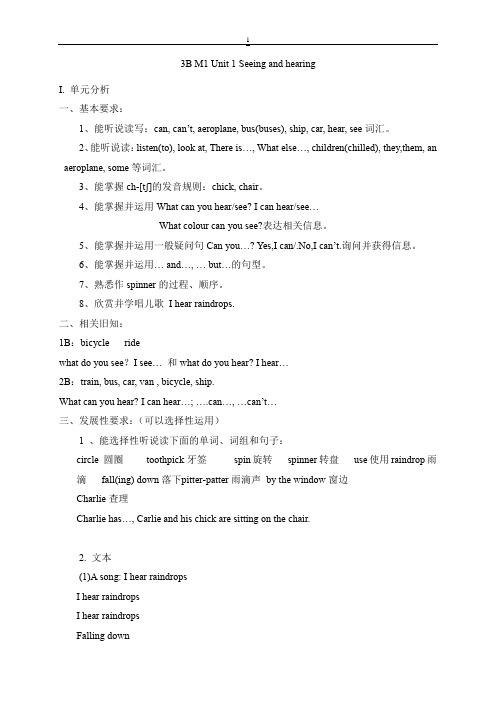
3B M1 Unit 1 Seeing and hearingI. 单元分析一、基本要求:1、能听说读写:can, can’t, aeroplane, bus(buses), ship, car, hear, see词汇。
2、能听说读:listen(to), look at, There is…, What else…, children(chilled), they,them, an aeroplane, some等词汇。
3、能掌握ch-[tʃ]的发音规则:chick, chair。
4、能掌握并运用What can you hear/see? I can hear/see…What colour can you see?表达相关信息。
5、能掌握并运用一般疑问句Can you…? Yes,I can/.No,I can’t.询问并获得信息。
6、能掌握并运用… and…, … but…的句型。
7、熟悉作spinner的过程、顺序。
8、欣赏并学唱儿歌I hear raindrops.二、相关旧知:1B:bicycle ridewhat do you see?I see… 和what do you hear? I hear…2B:train, bus, car, van , bicycle, ship.What can you hear? I can hear…; ….can…, …can’t…三、发展性要求:(可以选择性运用)1 、能选择性听说读下面的单词、词组和句子:circle 圆圈toothpick牙签spin旋转spinner转盘use使用raindrop雨滴fall(ing) down落下pitter-patter雨滴声by the window窗边Charlie查理Charlie has…, Carlie and his chick are sitting on the chair.2. 文本(1)A song: I hear raindropsI hear raindropsI hear raindropsFalling downFalling downPitter-patter, raindropsPitter-patter, raindropsFalling downFalling down(2). A rhymeCharlie has a chick.Charlie has a chair.Charlie and his chickAre sitting on the chair.(3) Mini-dialoguePeter: What can you see in the sky, Kitty?Kitty: I can see some…Peter: How many…are there?Kitty: There are…Peter: What colour are..?Kitty: They are…(4) A passage:It is rainy today. Alice and her brother Tom can’t go out and play. They can only stay at home. They are both standing by the window. They can hear raindrops. And they can see many cars and buses in the street. Alice likes listening to the raindrops, but Tom doesn’t. He likes watching the busy cars.四、情感与人文:善于观察、聆听身边的事物,热爱生活。
牛津上海版(试用本)三年级下册英语Module 2 Unit 2 Toys Period 3教案

Oxford English Book 3BModule2 Unit 2 Toys一、单元主题:Toys二、单课话题:Period 1:Toys we likePeriod 2:Showing our toysPeriod 3:Playing with toys三、教材及学情分析1.3B Module2 Unit2的教学主题和内容围绕Toys展开, 核心词汇为:toy train, doll, skateboard, robot, lovely; 核心句型为:What do you like? I like … 询问他人所喜欢的玩具。
教材中, Module 2的主题为My favourite things, 其中Module 2 Unit2的主题为Toys,根据本单元的教材内容,将三课时的话题设计为:Period 1 Toys we like,Period 2 Showing our toys,Period 3 Playing with toys希望学生通过本单元的学习,能够从玩具的颜色、尺寸、触感、功能等方面介绍喜欢的玩具,并在与同伴玩玩具的过程中分享快乐,增进彼此间的友谊。
2.本单元的核心词汇为有关玩具的单词:toy train, doll, skateboard,robot。
学生在一、二年级的学习中已经学习了一些有关玩具的单词以及Do you like…? Yes, I like…或No, I don’t like…来询问他人喜好并作回答。
通过以前的学习,学生能初步表达自己的喜好意愿。
本单元的学习将整合旧知,在学生已有的学习水平上进一步丰富、发展语言。
3.三年级学生通过近二年的英语学习对介绍玩具的主题比较感兴趣,但是由于之前语言输入量的匮乏只能简单的表达自己的喜好。
因此,在本单元的学习中将丰富学生的语言表达,让学生理解描述玩具可以从其颜色、尺寸、触感、功能等方面进行介绍。
在表达与交流的同时增进彼此的友谊,激发学习的兴趣,培养一定的思维品质和良好的口语交际能力。
小学英语上海教育出版社牛津深圳版三年级下册 Unit1 Colours 单元教学设计
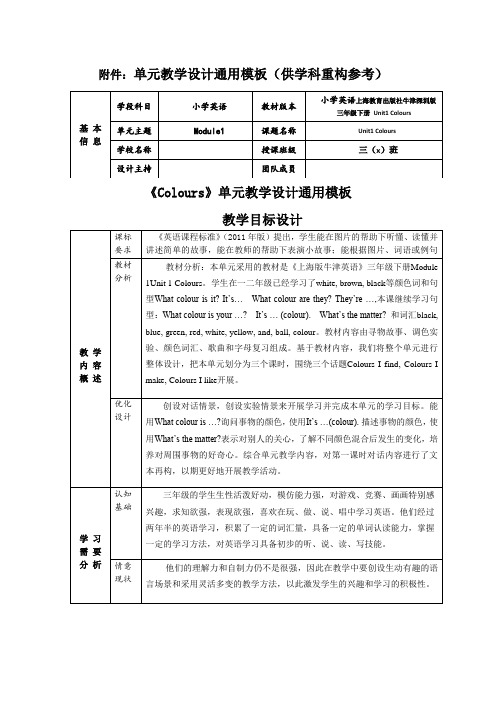
附件:单元教学设计通用模板(供学科重构参考)《Colours》单元教学设计通用模板教学目标设计学习评价设计教学策略设计《第一》课时教学设计教学目标设计教学策略设计知识并拓宽思维。
学习评价设计【主要内容】Task1. Lost and Found (失物招领)Boys and girls, there are many things in our Lost - and - found office. Please help the children find their belongs. One acts as the officer, and the other three act as the children. (亲爱的小朋友,失物招领处很多物品在等待着他们的主人呢。
请在四人小组内按角色扮演,一人扮演失物招领officer ,另三人扮演来寻找物品的小朋友。
)Task3. Ask , answer and colour亲爱的A 组小朋友,你拿到的是Group A 彩色、Group B 黑白的图片练习纸;你的同桌拿到的是Group A 黑白、Group B 彩色的图片练习纸。
A 组学生要通过问题,了解B 组图片的颜色并涂色,而B 组则反之要通过问题了解A 组图片的颜色并涂色。
For example: What colour is ……?【评价反馈】1.本练习采取小组合作完成形式,检测学生是否能够根据课堂知识来进行练测。
【主要内容】1. Describe the colors of things in your house with your parents.2. Try to find more colors around you.【评价反馈】1.检测学生是否能够讲所学知识与生活实际结合,学以致用。
教学过程设计【歌曲导入,巩固旧知】1. 播放英语歌曲Sing a rainbow.教师与学生一起唱歌曲2. 师生问答,讨论Do you like the rainbow?What colour do you like?3.通过闪现各色气球,全体学生快速回答气球的色彩.【设计意图】1.演唱歌曲,营造英语学习氛围,活跃课堂气氛。
“牛津上海版”小学英语三年级(下)知识点大全
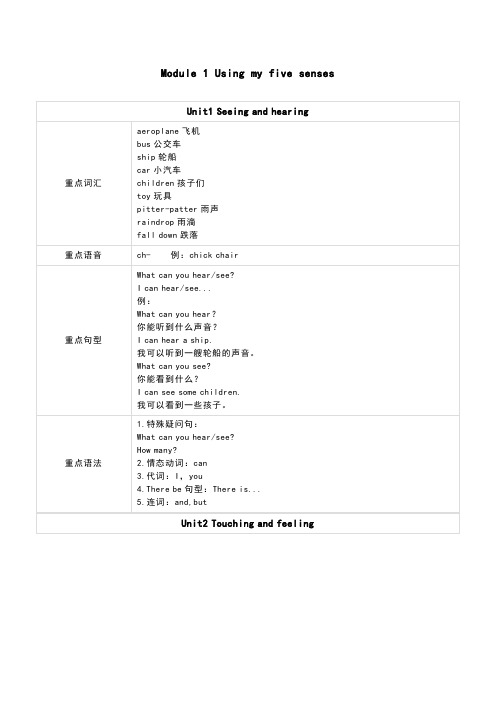
Do you like...? Yes,I do./No,I don’t. 例: Do you like elephants? 你喜欢大象吗? Yes,I do. 是的,我喜欢。 Do you like tigers? 你喜欢老虎吗? No,I don’t. 不,我不喜欢。
I have... My...is/are... 例:I have two eyes.My eyes are big. 我有两个眼睛。我的眼睛大。
Of course.当然。
1.动词 have:I have... 2.一般疑问句:Can you...? 3.Be 动词: These are... They are... 4.代 词 : my,me,myself,yourself
May I have a try? Sure. 我能试下吗?当然。
1.特殊疑问句: What is it? What’s this/that? What are these/those? 2.一般疑问句: Are they...? 3.Be 动词:It's/They're...
重点词汇 重点语音
重点句型
补充句型 重点语法
Module3 Things around us
Unit1 Shapes
circle 圆形 square 正方形 triangle 三角形 star 星形 rectangle 长方形
-ff 例:turn off take off
What shape is it? 它是什么形状的? It’s a circle. 它是一个圆形。
重点语法
1. 祈 使 句 : 动 词 原 形 开 头 例:Close your eyes./Smell this. 2. 特 殊 疑 问 句 : How does it smell/taste? What is it? 3.一般疑问句:Is it...? 4.Be 动词:It's...
新人教版PEP上海牛津3起点英语三年级下册Unit1 知识点总结教案2
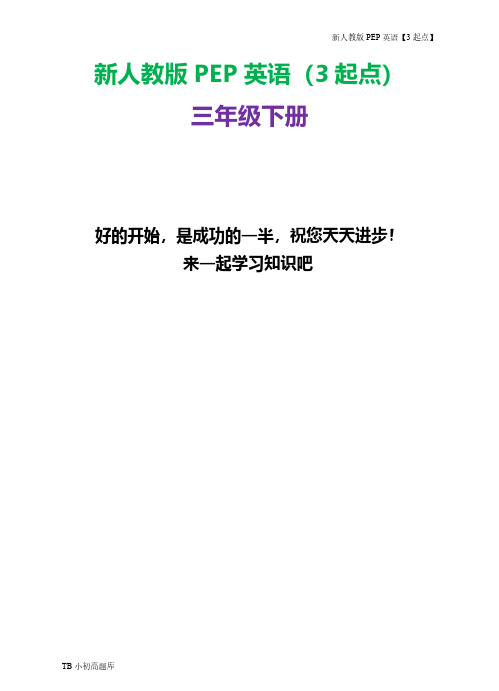
一、读一读、听一听并圈一圈。 1.cat bag
TB 小初高题库
2.bag dad 3.Canada panda 4. hand dad 二、找出发音与众不同的单词。 1. bag cat cake dad plate Kate hand 3.China Canada cat ant 三、判断下列对话正误,正确的打“√”, 错误的打“×”。 ( )1、A:Where are you from?
B: I’m Mike. ( )2、A:Good afternoon?
B: Good morning. ( )3、A:Where are you from?
B: I’m from Shandong.
分钟 5
课下作业
一、看图读单词,找朋友。
1.
2. cake
新人教版 PEP 英语【3 起点】
face
二、选在合适的答语: 1.Nice to see you. __________________
板书设计 Unit 1
Welcome back to school
上课前打好的四线三格,在课堂上随讲随写的四个单词 教学反思
Unit 1 A Let’s spell
分钟 2
课前预习
一、回忆 A 部分对话。
Where are you from?
I’m from….
二、复习上册字母 A 的发音
分钟 8
当堂达标
B: Nice to meet you, too.
ቤተ መጻሕፍቲ ባይዱ
3.请学生表演 A 部分 Let’s talk 的对话。
教学环节 师生活动 Presentation 新知呈现 (二)呈现新课(Presentation) 1.教师出示字母卡并问:What’s it? An“ Aa”. What’s the sound of letter “A”? 引导学生说出元音字母 a 在单词中的发音/æ/。 2.出示含有这个字母相同发音的单词图片。 /æ/ cat bag hand dad
沪教牛津版三年级下册英语 全册教案
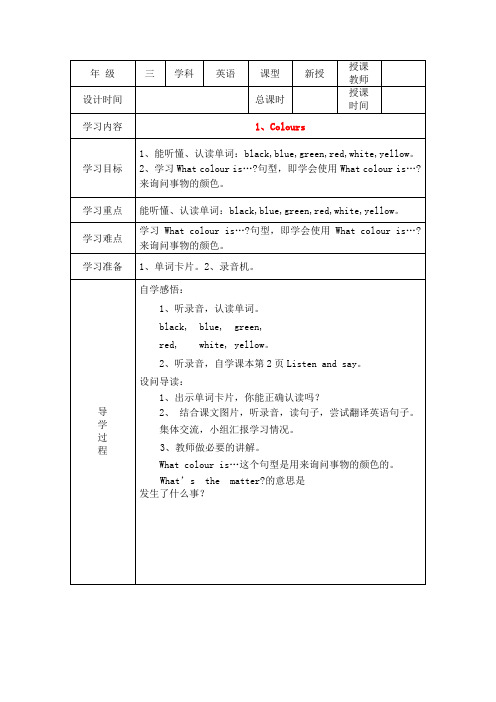
三年级英语下册教学计划2015-2016学年第二学期一、学情分析通过上个学期的学习,学生们对英语已经有了一定的了解,并掌握了一些日常对话用语和一定量的词汇。
但是仍然有一部分学生对学习英语有一定的困难,需要本学期来加强学习英语的能力,同时本学期应该在课堂上加强学生的英语口头表达能力。
二、教材分析(一)教学内容本册教材由内容独立但具有内在联系的四个模块构成。
四个模块分别是Using my five senses( 使用我的五种器官)、My favourite thing (我最喜爱的东西)、My colourful life(我的多彩生活)、Things we enjoy(我们喜欢的事)。
每个模块包含三个单元,每单元四页,由5-6个栏目组成。
所有栏目分成核心学习栏目和辅助学习栏目,前者为新语言知识的呈现部分,学生通过插图了解单词词义,通过插图、录音和文字所提供的简单语境感知新语言(Listen andsay Look and learn栏目);后者为语言活动部分,学生通过听、说、读、写、玩、演、唱等多种方式巩固与拓展语言知识和技能并运用语言( Say and act / Sing a song / learn the sounds/enjoy a story等栏目)。
在每个模块后还安排一个复习模块和一个课题,对该模块所学语言知识进行回顾和总结。
(二)教学目标1、逐渐形成学习英语的兴趣和爱好,形成在真实环境中使用英语进行活动的积极性。
2、能运用英语在日常生活和课堂情景中与老师和同学进行初步交际,如问候他人,家庭和朋友的简单消息。
3、能参加运用英语组织和开展的日常课堂教学和生活游戏,及其它课内外活动。
4.能听懂简单的指令并作出适当的反应,能读懂简单的配图小故事,进行口头描述,唱一些英语歌曲,背一些小诗和歌谣。
5、养成良好的学习英语的基本方法;形成英语学习的自觉性,和通过英语学习,获得更多知识的求知欲。
6.养成良好的文明行为习惯,掌握基本的英语交际礼貌策略,全面提高综合素质。
牛津小学英语译林版英语三年级下册英语全册教案(有教后记)
在课文学习部分,让学生先通过看卡通,整体感知文本,并找出是谁迟到了,培养学生 听故事的能力。接着让学生找出 Mike 和 Mr Green 在那种情境中是怎样说的,引出 I’m sorry./Come in, please.的教学,这里引导学生关注课文的细节信息,培养学生结合插图理解意 思的能力。接下来再结合图片学习 Open the door./Close the window.两句,然后让学生逐句学 读课文并用多种方式培养学生读的能力,养成良好的模仿语音语调的习惯。最后让学生自己 表演课文,巩固课文学习。在这个环节,教师提出不同层次的表演要求,让学生参与评价。
home. You can choose one to make a dialogue. 【设计意图:通过学生练习,明确用法,让生初步接触祈使句的概念。】
Homework 家庭作业
Y
1. Read the dialogue after the tape and imitate the pronunciation.
3
ll
Mark
1. Look at the pictures. (PPT 呈现) Can you say the phrases? 2. Please think and fill in the blanks. (PPT 呈现) 3. You all did very well. In this lesson, we’ve learnt how to give orders,
牛津上海版(试用本)三年级下册小学英语教案(全册)
Module 1 Using my five sensesUnit 1 Seeing and hearing教材分析本节课重点学习辨认、识别:单词car, bus, aeroplane, ship等,句型What can you see? I can see...。
重复并表演对话内容,培养学生的语言运用能力,培养学生的感知能力,感受生活中的美。
教学目标1. Knowledge aims:Words: car, bus, aeroplane, shipSentences: What can you see? I can see a/some…What else`can you see? I can see…What can you hear? I can hear…2. Ability aims:Identifying the key words.E.g. car,bus,a eroplane,shipUsing wh-questions to find out what is seeing and hearing.E.g. What can you see? I can see a/some…What else can you see? I can see…What can you hear? I can hear…3. Emotion aims:Let students learn to observe things around them.教学重难点Main points1. Identifying the key words.2. Using wh-questions to find out what is seeing and hearing.Difficult points1. Using nouns to identify vehicle .2. Using wh-questions to find out what is seeing and hearing.课前准备多媒体课件、录音机、教学素材教学过程Step1.Greeting1.Greeting.2.Asking student “Do you know how to use our five senses”. Step2. Presentation1.Learn new words and sentences:1)Look! What can you see?I can see _____________________.There is /are ____________________.2)Listen! What can you hear?I can hear ______.2.DialogueShow some pictures to let students make a dialogue.A:Look, What can you see?B:I can see a ______.A:What else can you see?B:I can see ______.A:What colour can you see?B:I can see a ______.A:What can you hear?B:I can hear a ______.Step3.Practice1.Play a gameMake a spinner1).Draw a circle.2) Cut the circle.3) Colour the circle.4) Use a toothpick.5) Spin the spinner.2.What colour can you see?3.How many children?4.What can the little bird see?It can see ___________.5.Can the ladybird see them?Can the ladybird hear them?6.Listen and enjoy7.按要求改写句子。
(沪教牛津版)三年级英语下册教案 MODULE2 unit3 Lesson1
(沪教牛津版)三年级英语下册教案Module2Unit 3 People I likeThe first period1、任务前期准备阶段(Pre-task preparation section)Activity 11、教学辅助(Aids)1) 音乐2)图片2.活动过程(Process)Steps Contents Methods Purpose1 Sing a song Sing the song together: 通过唱歌调动课堂气氛,引出主题: “Friends”2 Introducetheir friends 通过歌曲:引出:Who’s your friend? Wouldyou please introduce to us?让学生用学过句型和单词作介绍:My friend is…. She/He is….(fat/thin/big/little/tall/short…)通过让他们介绍自己的朋友,复习3A教学中所涉及的介绍朋友的内容,从而达到复习旧知识,为下面新授作铺垫。
Activity 21、教学辅助(Aids)1)电脑2)屏幕2.活动过程(Process)Steps Contents Methods Purpose1 复习:How old ishe? 告诉学生,今天我带来了一个新朋友你们想认识吗?教师三句话Is he….?What can he do? Can he…..? T: He is a boy. He’s fromBritain. He is very famous.Who’s he?让学生通过提问的方式猜。
介绍新朋友,激发学生兴趣,让学生通过提问的方式揭示谜底,提供学生开口的机会,培养学生用英语思维的能力。
2 Elicitation:Harry Potter 揭示谜底:(画面定格:HarryPotter)1.问学生是否看过这个电影,对他的印象如何?对于Harry Potter有哪些问题可以直接问他:How old are you?Can you….?Do you like….?Have you….?2. 先让学生来回答,或者让语言表达能力比较强的学生来描述。
三年级下册英语教学计划优秀7篇
三年级下册英语教学计划优秀7篇小学三年级英语下学期教学工作计划篇一1.班级学生基本情况分析我所执教的三(2)班学生人数为20人,大部分学生基本能适应英语课堂教学,基本掌握所学内容,有大约四分之一的同学较为突出,能适应高一层次的教学要求,有少数几位男同学的基础不扎实;学生的学习态度也呈两极分化,部分孩子已养成较好的听说英语进行复习预习的习惯,也有两三位同学学习态度不端正,听课习惯差。
2.课程标准对本册教材的要求思想品德方面:培养学生的爱国主义精神,使学生学会与他人自然交往,善于合作。
知识技能方面:1)能听懂会说12组对话,并能进行简单的交流;(A、B、C类学生)2)能听说认读50个单词和听说读写26个字母,并能简单运用;(A、B、C类学生)3)能听做6个TPR活动(A、B、C类学生)4)能学会小制作;(A类学生)5)能唱8首歌曲。
(A、B类学生)6)能听说唱7首歌谣;(A、B、C类学生)7)能完成8个自我评价活动;(A、B类学生)8)能听懂6个幽默小故事;(A类学生)9)能了解6项简单的中西方文化知识。
(A类学生)学习态度及习惯方面激发学生的学习英语的兴趣,对英语学习具有积极的学习态度,有学习的信心,具备良好的语音语调书写基础,具有认真听大声说仔细读正确写的习惯。
能力方面培养学生的观察力,记忆力,用英语进行直接思维的能力,进一步发展学生的想象力和创造能力。
3.全册教材基本内容说明全册教材从内容形式方法插图及装祯设计等方面都以最大限度地激发学生的学习动机和兴趣为宗旨。
教学内容紧密联系小学生的生活和学习实际,选择话题充分考虑到小学生的需求,本册书共6个单元,2个复习单元,每单元分ABC三个部分,共10页。
复习单元为6页。
共分为以下几个话题。
单元题目话题Unit1 Welco me back to school ClassmatesUnit2 My family Family membersUnit3 How many?NumbersRecycle1Unit4 Do you like pears?FruitsUnit5 Where is my ruler?LocationUnit6 At the zoo AnimalsRecycle2全册教材的重点难点本册教材的重点为字母教学,会话教学和词汇教学,其中字母教学是重中之重,因为它是英语学习的基础,对学生今后的`发音拼读和记忆单词都至关重要。
- 1、下载文档前请自行甄别文档内容的完整性,平台不提供额外的编辑、内容补充、找答案等附加服务。
- 2、"仅部分预览"的文档,不可在线预览部分如存在完整性等问题,可反馈申请退款(可完整预览的文档不适用该条件!)。
- 3、如文档侵犯您的权益,请联系客服反馈,我们会尽快为您处理(人工客服工作时间:9:00-18:30)。
Module 1 Using my five sensesGrammar:1.Modal verbs ‘can/can’t: I can/can’t ---2.Wh-questions: What can you see /hear? What colour is it? What is it?3.Yes/No question: Is this your --- /Is it--- Yes, it is./ No, it isn’t.4.Possessive adjectives: your, my, her5.Imperatives: Listen to--- Touch --- Taste ---/Smell---/ Close ---6.Verb ‘to be’: It’s --- /It’s a/anV ocabulary:Mirror, can, hair, brown, eye, mouth, can’t, grey, listen to, street, roof, her, cage, aeroplane, bus, car, boat, drill, telephone, hear, soft, hard, rough, smooth, touch, how, does, feel, toy, pineapple, hat, cold, lemon, sweet, sour, taste, strawberry, lime, smell, nice, fish, prawnSounds: a ( Jane, make, aeroplane)a (fat, man, jam)e (she, see, these, tree, street)e (Eddie, ten, red, peg)Daily Expressions:Hello, this is --- (on the phone)How are you? I’m fine, thank you.How does it feel? Can I help you?Unit 1 Looking and seeingLanguage functions: Talking about abilityIdentifying and describing objects in terms of colourAsking and answering questions about possessionsSaying the sound ‘a’ in its open syllable form Language skills:Use modeled phrases and sentences to communicate with teachers and other learner.Pronounce correctly a series of words in a sentence withthe vowel sound ‘a’ in its open syllable formMain points: Can use the sentences: What can you see?/What colour is it? Difficult points: Yes/No questions: Is this your ---?Teaching beach:Using the old words and sentences to learn the new words and sentences. Using the things and pictures to learn the words.Teaching times: Five periodsThe First PeriodLanguage focus:Using nouns to identify different parts of the bodyUsing modal verb ‘can/can’t’ to talk about abilityLanguage skills:Use modeled phrases and sentences to communicate with teacher and other learners.Open an interaction by asking questionsMain points: Can use the sentence “What can you see? I can see---.”Difficult Points: Can spell the words and using the sentence.Materials: a mirror , a mask , a tape, Book 3BThe Second PeriodLanguage focus: Using nouns to identify thingsUsing predicative adjectives of colour to describe thingsUsing modal verb ‘can’ to talk about abilityLanguage skills: Using modeled phrases and sentences to communicate with teacher and other learnersMaintain an interaction by replying to questionsMain points: Can spell the words and using the sentences.Difficult points: Can recite the words and write the sentences. Materials: some colour pencils, rulers, rubbers ---The Third PeriodLanguage focus: Asking ‘Wh-‘ questions to find out various colo urs students see.Using modal verb ‘can’ to t alk about abilityLanguage skills: Identify a series of words in a sentence with the vowel sound ‘a’ in its open syllable formUsing modeled phrases and sentences to communicate with teacher and other learners.Main points: Can say the sentences. Pronounce correctly a series of words in a sentence with the vowel sound ‘a’ in its open syllable form.Difficult point: Can use the sentences.The Fourth PeriodLanguage focus: Using possessive adjectives to show possession. Language skills: Use modeled phrases and sentences to communicate with teacher and other learners.Close an interaction by using appropriate formulaic.Main points: Can use possessive adjectives to show possession.Can ask and answer the sentences.Difficult points: Can contract my/your. Can copy the sentences. Materials: Cassette 3B and a cassette player Workbook 3B P3The Fifth Period (Exercises)Language focus: Asking and answering questions about possessions Talking about ability.Language skills: Use modeled phrases and sentences to communicate with teachers and other learners.Pronounce correctly a series of words in a sentence with the vowel soundLanguage functions: Identifying objects by their soundsResponding to simple instructionsUsing telephone formulaeSaying the sound ‘a’ in its closes syllable form.Language skills: Open an interaction by eliciting a responseMaintain an interaction by using phrases to replyMain points: Can use imperatives to give instructions and directions. Can use the sentences to ask and answer.Difficult points: Can say and write the phrases .Teaching times: Five periodsThe First PeriodLanguage focus: Using imperatives to give instructions and directions Using nouns to identify things.Language skills: identify key words in an utterance by recognizing stress. Main point: Can spell and read the words.Can use imperatives to give instructions and directions.Difficult point: Can use the phrases .The Second PeriodLanguage focus: Using imperatives to give instructions and directions Using nouns to identify things.Language skills: identify key words in an utterance by recognizing stress. Main point: Can make a new rhyme. Can say and recite the words. Difficult point: Can make a new phyme.The Third PeriodLanguage focus: Using modal verb ‘can’ to talk about abilities.Asking ‘Wh-‘ questions to find out various kinds of specific information about a person.Language skills: Open an interaction by asking a question.Pronounce correctly a series of words in a sentence with the vowel sound ‘a’ in its closed syllable form.Main point: Can use modal verb ‘can’ to talk about abilities.Difficult point: Can ask ‘Wh-’ questions to find out various kinds of specific information about a person.Materials: Cassette 3B ,Workbook P5, Wallpictures 3BThe Fourth PeriodLanguage focus: Using formulaic expressions to start a telephone conversation.Using formulaic expressions to greet people and respond to greetings. Using imperatives to give instructionsLanguage skills:Using modeled phrases or sentences to communicate with other learners Maintain an interaction by replying to a question.Main point: Can use imperatives to give instructions.Difficult point: Use imperatives to give instructions.Materials: Cassette 3B and a cassette playerLanguage focus:Using modal verb ‘can’ to talk about abilities.Asking ‘yes/no’ questions using modal verb ‘can’ .Language skills:Use modeled phrases or sentences to communicate with other learners. Open an interaction by asking a question.Main point: Can use the sentences to ask and answer.Difficult point: Asking questions using modal verb ‘can’. Materials:Unit 3 Touching and feelingLanguage functions:Identifying objects by touchAsking questions about and describing the way things feelIdentifying letters of the alphabet shapesResponding to simple instructionsSaying the sound ‘e’ in its open syllable fo rmLanguage skills:Use modeled sentences to communicate with other learnersOpen an interaction by eliciting a responseProduce simple sentences involving listsPronounce correctly a series of words in a sentence with the vowel sounds ‘e’ in its open syll able formTeaching times: Five periodsThe First PeriodLanguage focus:Using adjectives to describe things.Using imperatives to give instructionsAsking ‘How’ questions to find out the texture of a thing.Asking ‘Wh-’ questions to find out a specific thi ng.Language skills:Maintain an interaction by replying to a question.The Second Period Language focus:Using adjectives to describe thingsUsing imperatives to give instructionsAsking ‘How’ questions to find out the texture of a thing Language skills:Locate specific information in response to simple questions Open an interaction by asking a questionMaintain an interaction by replying to a questionMain point:Can use the question to find out the texture of a thing Difficult point:Can use two adjectives to describe thingsMaterials:A soft toy, a bag, a balloon, an apple and a pineappleCassette 3B, Photocopiable P6,7The Third PeriodLanguage focus:Asking ‘How’ questions to find out the texture of a thingAsking ‘yes/no’ questions to obtain simple responsesLanguage skills:Locate specific information in response to simple questionsOpen an interaction by asking a questionMaintain an interaction by replying to a questionPronounce correctly a series of words in a sentence with the vowel sound ‘e’ in its open syllable formMaterials:Cassette 3B Wallpictures 3B Workbook P7Module 1 Unit 4 Tasting and smelling Language functions:Indentifying objects by taste and smell.Asking questions about and describing the taste and smell of objects Responding to simple instructionsSaying the sound ‘e’ in its closed syllable formLanguage skills:Use modeled sentences to communicate with teachers and other learners Open an interaction by eliciting a responsePronounce correctly a series of words in a sentence with the vowel sound ‘e’ in its closed syllable formTeaching breach: Use the fruits and the food to learn the words.Act and practice the sentences.Teaching times: Five timesThe First PeriodLanguage focus :Using nouns to identify thingsUsing adjectives to describe thingsUsing imperatives to give instructionsAsking ‘Wh-’ questions to find out a specific thingsLanguage skills:Open an interaction by asking a questionMaintain an interaction by replying to a questionMain point: Using adjectives to describe thingsTeaching beach: Using the fruits and food to taste and try to say.The Second PeriodTeaching aims: Have the students to ask and answer the questions.Have the students to read the words and sentences.Language focus: Using nouns to identify thingsUsing adjectives to describe thingsA sking ‘Wh-’ questions to find out a specific thingTeaching breach: Using the things and practice.Materials: Cassette some ap0ples , some oranges , a lemon, a banana, a strawberry, a limeThe Third PeriodTeaching aims: Have the pupils to pronounce the words and vowel ‘e’ in closed syllable correctly.Have the pupils to ask the feelings.Language focus: Using nouns to identify thingsUsing adjectives to describe thingsDifficult point: Can pronounce correctly a series of words in a sentence with the vowel sound ‘e’ in its closed syllable formMain Point: Can pronounce correctly a series of words in a sentence with the vowel sound ‘e’ in its closed syllable formMaterials: a pineapple, a prawn, a dried prawn, sweets, cakes , different kinds of fruit.The Fourth Period Teaching aims: Have the pupils to act out the dialogue.Language focus: Using formulaic expressions to start a conversation Using formulaic expressions to request somethingDifficult point: Using formulaic expressions to start a conversation Main Point: Can make a small dialogue about shopping Materials: some fruits cassetteModule 2 My favourite thingsUnit 1 Animals I likeLanguage focus: 1.Wh-questions: What are they?2. Yes/No question: Do you like…?3. Verb “to be”: They are…4. Countable nouns(plual)Skills:Speaking e modelled phrases and senyences to communicate with a teacher and other learns2.Open an interaction by eliciting a response3. Maintain an interaction by providing information to factual /yes/no questions4.Pronounce correctly a series of words in a sent ence with the vowel sound “i” inits open syllable formListening 1 Identify key words in an utterance by recognizing the stress2. Locate specific information in response to simple questions3. Identify a series of words in a sentence with the vowel sound”i” in its opensyllable from.Writing Develop written text by repr oducing sentences from teacher’s writing.Diffcult points 1.Wh-questions: What are they?2. Yes/No question: Do you like…?3. Verb “to be”: They are…4. Pronounce correctly a series of words in a series of words in a sentence withthe vowel sound “i” in its open syllable formTeaching aids: Pictures,tapeTeaching times fourFirst period: Look and learn, Look and say, Ask and answerSecond period: Look,red and say . Ask and answerThird period: Read and guess. Learn the soundFourth period: ReviewFirst PeriodContents: words: cats , dogs, rabbits, lizards, snakes, birdsSentences: Do you like cats? Yes, I like … No, I don’t like …I like… Language focus: Using nouns to identify different animals. E g. snakesUsing simple present tense to express interests and preferences.Ask yes/ no questions to obtain simple responses.Contents: words: lions, tigers, zebras, elephants, giraffes, pandassentences: Do you like…? Yes, I like … No, I don’t like …Language focus: Using nouns to identify different animals.eg. pandasUsing simple present tense to express interests and preferences.Ask yes/ no questions to obtain simple responses.Third PeriodContents: sentences:They’re tall/big/black/…What are they? They’re____s.Lan guage focus: Using adjectives to describe animals. eg. They’re tall.Ask “wh”questions to find out about animals. eg. What are they?Contents: Review Unit1Difficult points: Do you like…? Yes,I like… No,I don’t like…What are they? They are…Module 2 My favourite thingsUnit 2 Toys I like: Language focus: 1 .Wh-questions: What do you like?2. demonstratives: these, this3. pronoun: weSkills:Speaking e modelled phrases and senyences to communicate with a teacher and other learns2.Open an interaction by eliciting a response3. Maintain an interaction by providing information to factual /yes/no questions4.Pronounce correctly a series of words in a sentence with the vowel sound “i” inits closed syllable formListening 1 Identify key words by recognizing the stress2. Locate specific information in response to simple questions3. Identify a series of words in a sentence with the vowel sound”i” in its closedsyllable from.Wri ting Develop written text by reproducing sentences from teacher’s writing.Diffcult points 1.Wh-questions: : What do you like?2. demonstratives: these, this3.Pronounce correctly a series of words in a sentence with the vowel sound “i”in its closed syllable formTeaching aids: Pictures,tapeTeaching times fourFirst period: Look and say, Ask and answerSecond period: Read a story .Third period: Make a robotFourth period: Look and say, Do a survey,Learn the soundFidth period: ReviewFirst PeriodContents: words: super, beautiful, these, bicycle,dollSentences: Do you like these bicycles ? Yes, I like …No, I don’t like…These bicycles are super. I like this bear.Language focus: Using demonstratives to refer to people or things.eg:These bicycles are super.Using simple present tense to express interests and preferences.Eg: I like this bicycle.Second PeriodContents: words: skateboard(s), robot(s)sen tences: like … I don’t like …Language focus:Using simple present tense to express likes and dislikes.eg: like s kateboards. I don’t like robots.Contents: words: foil, glue, button, stick,sentences: Stick the foil / boxes / buttons.My name’s Ben. I’m Ron the robot.Language focus: Using nouns to identify things. Eg. Boxes, foilUsing imperatives to give instructions. Eg: Stick the foilAsk “wh”questions to find out about animals. Eg. What are they? Materials: some boxes, glue, some buttons, foil, recorderContents: sentences: Do you like …? Yes,we like …No, we don’t like…sound: i--- / I /Language focus:Ask ‘yes/no’ questions to obtain simple responses. Eg: Do you like balls?Ask ‘Wh-’ questions to find out various kinds of specific informationabout a person. Eg. What do you like?Using simple present tense to express likes and dislikes.eg. we like …wedon’t like…Contents: Review Unit2Difficult points: Do you like…? Yes,we like… No,we don’t like…What do you like? I like…/ We like…Materials: recorderModule 2 My favourite thingsUnit 3 People I like: Language focus: 1.Wh-questions: Who’s she? Who’s that?Where’s…? What’s in your hand?What do you like?2. Possesive adjectives : his3. verb “to have”: I have…4. How question: How are you?How is Ben?5. Demonstratives: this / thatSkills:Speaking e modelled phrases and senyences to communicate with a teacher and otherlearns2.Open an interaction by introducing oneself.3. Pronounce correctly a series of words in a sentence with the vowel sound “o” inits open syllable formListening 1 Identify main ideas2. Locate specific information in response to simple questions3. Identify a series of words in a sentence with the vowel sound”o” in its opensyllable from.Writing Add personal ideas and information to writing when a framework is provided. Diffcult points 1. Wh-questions: What do you like?2. How question: How are you?3. Possesive adjectives : hisTeaching aids: Pictures,tapeTeaching times SevenFirst period: Say and act, Ask and answerSecond period: Look and say, Draw and write .Third period: Read and act a storyFourth period: Read and act a storyFifth period: Say and act,Sixth period: Review soundSeventh period TestFirst PeriodContents: sentences:How old are you? How old is she / he/ Ben /…What’s your / his / her/ your brother’s /your sister’s name? Language focus:Usingformulaic expressions to instroduce oneself and others.Asking ‘Wh’ questions to find out a person’s identity.eg.Who’s she?Asking ‘How’ questions to find out their age. eg.How old are you?Difficult points: What’s your / his / her/ your brother’s /your sister’s name?Contents: sentences: How old is she / he/ Ben /…What’s his / her nam e?I have two friends.Language focus: Using adjectives to describe people.eg: Ben is tall and thin.Asking ‘Wh’ questions to find out a person’s identity.Asking ‘How’ questions to find out a person’s age.Using connectives to link information.eg. I have two friends. Difficult points: Using adjectives to describe people.eg: Ben is tall and thin.Contents: sentences: Take this to Grandma,little Lucy.Your… are… Go to bed.Are yo u all right? I don’t know.Language focus: Using imperatives to give instructions. eg.Take this to Grandma,Little Lucy.Asking ‘Wh-’questions to find out a person’s identity.Using adjectives to describle things. eg. Your eyes are big.Using nouns to identify things. eg. Your teeth are big.Diffiuclt Points: 1.Take this to Grandma,Little Lucy. 2.Act the story.Contents: sentences: Take this to Grandma,little Lucy.Your… are… Go to bed.Are you all right? I don’t know.Language focus: Using imperatives to give instructions. eg.Take this to Grandma,Little Lucy.Asking ‘Wh-’questions to find out a person’s identity.Using adjectives to describle things. eg. Your eyes are big.Using nouns to identify things. eg. Your teeth are big.Contents: se ntences: May I come? Come in,please.What’s in your hand?What do you like? I / We like…I / We don’t like… They’re…Language focus: Using formulaic expressions to ask for permission.eg. May I come in?Asking ‘wh’questions to find out various of specific informationabout a person.eg. What do you like?Diffiuclt Points: Using formulaic expressions to ask for permission.eg.May I come in?Contents: 1. Learn the sound2.Review Unit 3Language focus: Pronounce correctly a series of words in a sentence w ith the vowel sound “o” in its open syllable formDiffiuclt Points: What’s his/ her name? What do you like? I/ We like…Module 3 Things around usUnit 1 ColoursLanguage focus: 1.Wh-questions:What colour is / are…?Who is she / he?2. Verb “to have”: She/ He has…Skills:Speaking e modelled phrases and sentences to communicate with a teacher and other learners2. Use appropriate intonation in questions and statements3..Open an interaction by eliciting a response. E.g. what’s that house?4.. Pronounce correctly a series of words in a sentence with the vowelsound “u” in its open syllable formListening 1 Identify key words in an utterance by recognizing stress2. Recognizing rhyming and onomatopoeic words3. Identify a series of words in a sentence with the vowel sound “u” inits open syllable from.Diffi cult points : What colour is / are…?Verb “to have”: She/ He has…Teaching aids: Pictures, tapeTeaching times: Four PeriodsFirst period: Sing a song, Look and tickSecond period: Look and say, Ask and answerThird period: Look and learn, Read and guessFourth period: Review, Learn the soundFirst PeriodContents: Sing a song “The rainbow”Words and express: rainbow, violet, in the sky, Look at the ... Language focus:Using predicative adjectives of colour to describe things. E.g. purpleUsing prepositions to indicate position/place/direction. E.g. Look at the rainbow. Difficult points:Pronounce the words correctly.Teaching breach: Using the song to learn the words.Materials: pictures, recorder。
